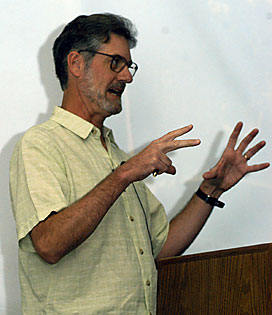 |
|
JUSTIN BARKER/Arizona Daily Wildcat
|
Alfred McEwen, professor of planetary sciences, talks yesterday about the Galileo spacecraft. The craft, which was launched in 1985, was designed to explore Jupiter. Galileo was intentionally crashed into Jupiter yesterday to end its service.
|
|
|
By Ashley Nowe
Arizona Daily Wildcat
Monday September 22, 2003
UA scientists gathered yesterday to watch the Galileo spacecraft crash into Jupiter for its final mission.
The 14-year-old NASA spacecraft, which was designed to study Jupiter and its moons, was intentionally plummeted into Jupiter at 12:49 p.m. in order to protect Europa, one of Jupiter's four moons.
Scientists working on the mission did not want Galileo to contaminate Europa after discovering that the moon has a salty ocean under a shield of ice.
"An ocean is often a sign of life," said Loretta McKibben, solar system ambassador for NASA and systems programmer for the Lunar and Planetary Laboratory.
"If Europa does have life, the microbes from Galileo could kill it off or tamper with it," she said.
Spacecrafts were not decontaminated in 1989, the time Galileo was launched, and, with little fuel left in the craft, scientists felt that it was safer to crash it into the gaseous Jupiter, McKibben said.
"The last thing you want is to go back 10 years later and find terrestrial life," said UA research scientist Elizabeth Turtle, who has worked on the project since 1999.
After watching Galileo plummet, UA scientists involved with the mission spoke of its trial and tribulations, but also celebrated the spacecraft's long life.
"It's a sad day," McKibben said. "It was the faithful little spacecraft that could."
Galileo overcame many difficulties including camera failures and stubborn antennas that would not release, Turtle said.
"It is commendable that Galileo actually had to be crashed in order to end its mission," Turtle said. "We thought it would fail much sooner from technical difficulties, but each time the engineers came up with a solution."
Galileo was intended to orbit Jupiter 10 times, but instead completed 33 orbits, giving scientists a wide array of information about the planet and its moons, said Alfred McEwen, director of the Planetary Image Research Laboratory at UA's Lunar and Planetary Laboratory who worked with the spacecraft's imaging team since before its creation.
Despite all its difficulties, Galileo was the first spacecraft that ever measured Jupiter's atmosphere and the first that flew by an asteroid.
"We hate to see this loyal spacecraft go," McKibben said. "But it has given us a lot of information over the years."
The spacecraft documented Jupiter's thunderstorms, with lightning 1,000 times more powerful than that on Earth.
It also took photographs of Europa's surface, which looks similar to some of Earth's polar regions, McEwen said.
"Europa appears to be the best place that life could have evolved in our solar system besides Earth," McKibben said.
The crash did not affect Jupiter because of its vast size, McEwen said.
The atmosphere absorbed the impact, causing the 3,000-pound spacecraft to vaporize, McKibben said.
It will be 2011 before another spacecraft ventures to Jupiter's orbit.
The Jupiter Icy Moons Orbiter is in a proposal phase, and, if all goes well, data could be received by 2019, McEwen said.
UA researchers hope to be involved with this mission as well.
"We saw incredible things like volcanic eruptions on Jupiter's moon Io," Turtle said. "I hope to participate on the next mission and learn as much as we did here."
